What makes mothers all that they are
Might as well ask what makes a star
Ask your heart to tell you her worth
Your heart will say, heaven on earth
Another word for divine
Your mother and mine
“Your Mother and Mine”—Peter Pan
“The doctrine of a Heavenly Mother is a cherished and distinctive belief among Latter-day Saints.” [1]
The belief of a divine feminine is rare in Christian religions. Although individual beliefs regarding the gender of deity differ, typically, God is viewed as a man, and believers and nonbelievers alike most often use male pronouns to refer to God. [2] Though the Church of Jesus Christ of Latter-day Saints believes in a male deity, they also believe in someone in addition—namely, a Mother in Heaven who rules in equality and power alongside a Father in Heaven. [3] This doctrine was taught to early Church followers during the Restoration of the gospel, [4] and Heavenly Mother was described in early Church hymns. [5] Heavenly Mother is also sometimes discussed in formal church settings [6] and even more commonly in casual cultural settings. [7] However, little research has explored perceptions of Heavenly Mother among Latter-day Saints themselves, though perceptions of deity have a large impact on a number of spiritual, social, and familial outcomes. [8] Accordingly, the current study consists of a large quantitative study of over 4,000 Latter-day Saints and examines their perceptions of Heavenly Mother. The study also analyzes open-ended qualitative data to further understand the many ways Latter-day Saints think about their female divine.
Though Heavenly Mother appeared to be commonly discussed in the early Church, According to scholars, church leaders may have made an effort in the 1900s to be more aligned with modern Christianity following the termination of polygamy. This resulted in less-mainstream Christian teachings falling by the wayside. [9] Thus, discussions around Heavenly Mother became less common and a “sacred silence” myth around Her began to grow. [10] This myth had many explanations (e.g., She is too sacred to discuss) and was perpetuated across Church culture without any formal Church statement or mandate not to discuss Heavenly Mother.
Groundbreaking research in 2011 by Paulsen and Pulido [11] examined this silence in depth. They analyzed all statements by Church leaders since the Church was organized for discussion of Heavenly Mother or Heavenly Parents. Their research suggested that Heavenly Mother has been regularly discussed by Church leaders throughout the history of the Restored Church, going against the “sacred silence” myth that had become endorsed by Church members. Indeed, they found over 600 separate Church sources acknowledging the belief in a Heavenly Mother. This article became a catalyst for a cultural revolution in the restored Church of Jesus Christ around the doctrine of Heavenly Mother. A gospel topics essay about Heavenly Mother was published on the Church website. [12] Poetry, artwork, and other creative outlets depicting Heavenly Mother increased among Latter-day Saints [13] with the image of Heavenly Mother even being shown in books published by the Church. [14] The Young Women’s theme was changed from “Heavenly Father” to refer to “Heavenly Parents.” [15] There seemed to be a new thirst for knowledge regarding Heavenly Mother by Latter-day Saints.
The research by Paulsen and Pulido (2011) provided many important insights regarding the ways in which Church leaders discuss Heavenly Mother. For example, Church leaders have referred to Her using a variety of titles (e.g., Heavenly Mother, Mother God, God the Mother, God the Eternal Mother, and the Eternal Mother). These researchers further discovered that She is generally discussed by Church leaders as a divine person—as a god. Furthermore, Paulsen and Pulido (2011) reported that Church leaders have described some of the many roles She plays in Latter-day Saint theology, including a heavenly wife and parent, a cocreator of worlds with Heavenly Father, a co-framer of the Plan of Salvation, and a concerned and loving parent involved in our daily lives. The current study is founded on these findings.
Many scholars have written about the theology of a Heavenly Mother and how She might fit in the Latter-day Saint religion. [16] However, little research has examined perceptions of a Heavenly Mother among Latter-day Saints themselves. Perceptions of deity can impact spirituality, [17] religious coping, [18] family relationships, [19] psychological adjustment, [20] support for harsh criminal punishment and militarism, [21] and gender ideology. [22] The psychological research is limited in terms of perceptions of a gendered God, but there are a few studies examining this topic. For example, perceiving God as solely male was associated with a more traditional view of gender, with participants being more likely to believe that “most men are better suited for politics, a preschool child is likely to suffer if his or her mother works, it is God’s will that women care for children, or that a husband should earn a larger salary than his wife.” [23] However, it is unclear whether those who hold those traditional views are influenced to see God as male or whether those who see God as male are influenced to hold traditional views. Either way, perceptions of God matter. To our knowledge, research has not yet examined how perceptions of a female divine impacts gender ideology. However, the belief in Heavenly Parents [24] who reign in equal partnership likely has a profound impact on multiple contexts of gender ideology, particularly for women. This could include a belief in the reality of eternal womanhood, the eternal nature of gender, and perceptions regarding a divine and beautiful identity. Though research has not thoroughly investigated these topics, we next turn to the existing psychological research on Heavenly Mother, which hints at how this belief might impact perceptions of self and others.
Psychological Research on Heavenly Mother
One study involved a qualitative examination of the perceptions of Heavenly Mother among Latter-day Saint women. [25] This research, which included interviews with 26 women, revealed a strong belief in a Heavenly Mother. Additionally, participants believed they were created in the image of Heavenly Mother, that creativity might be inherited from a Heavenly Mother, and that one way to honor Her was through the creative process, including art, poetry, childbirth, and so forth. Another study involved the “seekers of Heavenly Mother.” [26] This quantitative study included 527 followers of the social media site “Seeking Heavenly Mother” and focused on the methods used by individuals to seek Heavenly Mother. The most common methods involved conversations with other seekers, social media, meditation, a study of Church sources, and prayer. This research suggests that individuals in the Latter-day Saint religion are seeking Heavenly Mother in a variety of ways, and their views tend to be in line with official Church doctrine.
Though these studies provide an initial look into perceptions of Heavenly Mother, they are limited in a number of ways. First, they involve very small samples (e.g., N = 26) or are focused on a specific group of individuals (e.g., followers of a specific social media group). Research is needed to examine perceptions of Heavenly Mother among a wider sample of Latter-day Saints to fully understand how She is perceived. Additionally, though research has suggested specific roles and titles that Church leaders have used to describe Her, [27] research has not examined how the lay membership perceives these roles. Additionally, some research suggests that perceptions of Heavenly Mother might be gendered, with women perhaps connecting with Her more than men. [28]
The purpose of this study is to examine perceptions of Heavenly Mother among a large sample of Latter-day Saints, specifically focusing on the titles and roles delineated by Church leaders and reported by Paulsen and Pulido. [29] We also examine a number of moderators — including gender and age — that may impact perceptions of deity. [30]
The following research questions and hypotheses guide the current study:
- RQ1: How connected do Latter-day Saints feel to Heavenly Mother in comparison with Heavenly Father?
- RQ2: How often is Heavenly Mother discussed by Latter-day Saints in Church or personal settings?
- RQ3: What are Latter-day Saint beliefs about Heavenly Mother?
- RQ4: What titles do Latter-day Saints feel comfortable using in reference to Heavenly Mother?
Study Design
Participants in this study were self-identified adult members of the Church of Jesus Christ of Latter-day Saints. Participants were recruited from a Qualtrics panel (N =215) and from a snowball sample from social media (N =4,347). [31] Participants completed the survey on their phone, computer, or tablet. Ethical approval was obtained from the university internal review board before the study began. It should be noted that the authors of this article did their best to maintain minimal bias while conducting analysis of all data reported in this study. Among the participants, 79.2% were women and 95.2% were Caucasian, White, or of European descent.
In regard to regions in which participants have lived (not counting full-time missions), about 92% have lived in the United States at some point in their life, and 27% have lived outside the United States. Within the United States, about 20% have lived only in the western United States their entire lives. For some portion of their lives, participants had lived in the northwestern United States (35%), western United States (68%), southwestern United States (27%), midwestern United States (29%), southeastern United States (18%), and mid-Atlantic or northeastern United States (27%). Globally, 27% of the sample (N =1172) had lived or currently resided outside of the United States (not including mission service). Of these, participants resided in Western Europe (30%), Asia (12%), Canada (9%), Latin America or the Caribbean (7%), Australia and Oceania (5%), Eastern Europe (4%), the Middle East (3%), South America (3%), Africa (2%), and multiple regions throughout their life (26%).
The average age of participants was 36.62 years old (SD = 12.16, range = 18–89 years old). Regarding their work or school situation, participants (who could choose more than one response) reported working full-time (38.7%), working part-time (24%), attending school full-time (13.5%), attending school part-time (5.3%), being an at-home parent full-time (29%), or being retired (3.6%). Moreover, 51.9 % of participants earn $80,000 or more per year. Further, 42.5% served a full-time mission for the Church of Jesus Christ of Latter-day Saints. Regarding their family situation, 17% reported being single, 4% reported being divorced or separated, 1% reported being a widow, and 78% reported being married. Of those who were married, they reported being in their marriage for an average of 14.25 years (SD = 10.90, range = 1–64 years). Participants reported that they had on average 2.40 children (SD = 2.11) and that they had on average 4.10 siblings (SD = 2.17). About 89% of participants still had their mother living, and about 83% still had their father living.
Quantitative Findings [32]
Survey questions came from a variety of reliable and valid measures often used in the study of relationship quality and connection within marriages and between parents and children. Sample questions and the corresponding scales are provided in the first paragraph following each subtopic heading. Full survey results are displayed in the “Figures” found in the Appendix of this document. Survey results are broken down by gender and age/generation.
Relationship Quality and Connection to Heavenly Parents
Participants were asked about their relationship to their Parents in Heaven, adapted from the parent relationship quality questionnaire [33] (i.e., “How would you describe your relationship with your Heavenly Father/Heavenly Mother?”) and based on a seven-point scale: (1) very distant to (7) very close. Across all participants, 98% reported believing in a Divine or Heavenly Mother before participating in the survey. Additionally, about 84% had considered or thought about a relationship with Heavenly Mother before taking the survey. The modal response was “close” for Heavenly Father but “neither distant nor close” for Heavenly Mother. Overall, participants felt significantly closer to Heavenly Father than to Heavenly Mother [34] (see figure 1). That said, those who felt closer to Heavenly Father also felt closer to Heavenly Mother. [35] To explore further, gender and age were considered (see figure 1). There was no statistical difference between men and women in their relationship quality with their Heavenly Father. However, men reported a more distant relationship to Heavenly Mother than women did. [36] We looked at age continuously from younger to older and broke age into generations (Gen Z, millennial, Gen X, and baby boomer) to examine age by cohort. Looking at age continuously, there was a correlation with age and relationship quality with Heavenly Father, but no correlation between age and relationship quality with Heavenly Mother. [37] However, when examining age by generations, there were generational differences in relationships with Heavenly Mother [38] and Heavenly Father. [39]
Participants also reported how frequently they felt connected to Heavenly Mother and Heavenly Father, adapted from a parent contact measure [40] and based on a seven-point scale: (1) less than once a year to (7) daily (see figure 2). Overall, an individual’s connection to Heavenly Mother was statistically lower than an individual’s connection to Heavenly Father; [41] however, those who felt connected more frequently to Heavenly Father also felt connected more frequently to Heavenly Mother. [42] For example, the modal response was “daily” for Heavenly Father, but it was a tie between “less than once a year” or “a few times a year” for the modal response for Heavenly Mother. To explore further, gender and age were also considered (see figure 2). Men reported that they felt connected less frequently than women did to both Heavenly Father and Heavenly Mother. [43] Further, as age increased, individuals felt connected less frequently with Heavenly Mother [44] and Heavenly Father. [45]
In conclusion, since the existence of a Heavenly Mother has been regularly mentioned within church settings, it was not unexpected that nearly all men and women believed in both a Heavenly Father and Mother. [46] However, we found that men reported a more distant relationship to Heavenly Mother than women did. Previous scholars have discussed how a Heavenly Mother may fit into the Church’s doctrine; [47] however, we found that women clearly apply this doctrine to their personal life more than men do. While incremental age differences were not always found, examining age by generation to see cohort effects shed further light into Heavenly Parent relationships. Specifically, younger generations felt more connected with Heavenly Mother than older generations, a finding that may indicate an openness to this doctrine and a longing for a representation of both male and female deity.
Discussing Heavenly Mother
This section will explore participants’ beliefs and experiences about discussing Heavenly Mother. Participants reported on their beliefs regarding the appropriateness to discuss Heavenly Mother in church settings using a five-point scale—(0) No, it doesn’t reflect my personal beliefs to (4) Yes, it does reflect my personal beliefs—and whether they have experienced Heavenly Mother being discussed in church settings using a four-point scale—(1) never to (4) often. Participants also reported whether they discuss Heavenly Mother with close family or friends based on a four-point scale, (1) never to (4) often, and whether they believe Latter-day Saints do not discuss Her out of a sign of respect to Her sacredness using a five-point scale: (0) No, it doesn’t reflect my personal beliefs to (4) Yes, it does reflect my personal beliefs.
Participants reported on whether they personally believed that it is inappropriate to discuss Heavenly Mother in church settings (see figure 3). Overall, most individuals reported that this did not reflect their personal beliefs (72.5%). Only 13.3% of individuals reported that it did reflect their personal beliefs. In comparing groups, men are more likely to believe that it is inappropriate to discuss Heavenly Mother in church settings. [48] Finally, older individuals were more likely to personally believe that it is inappropriate to discuss Heavenly Mother in church settings. [49]
Participants also reported their personal experiences hearing Heavenly Mother discussed in church settings (see figure 4). Overall, people responded that they have never (20%) or rarely (64%) heard Heavenly Mother discussed in church settings. Only 15% reported discussing Her sometimes, with less than 1% reporting that She is discussed often in church settings. When comparing gender and age, significant differences were detected. Men reported discussing Heavenly Mother more often in church settings than women did. [50] Additionally, older individuals reported speaking of Heavenly Mother more often than younger individuals; however, they also reported they felt it was less appropriate to do so. Perhaps the belief that speaking of Heavenly Mother is inappropriate in church settings increases the perception that these discussions are happening more frequently. [51]
Furthermore, participants reported on whether they felt that “we do not speak of Heavenly Mother as a sign of respect to her sacredness” reflected their own personal beliefs (see figure 5). Overall, most individuals did not feel that this reflected their personal beliefs (57.4%). However, this belief differed by groups. Men were more likely than women to personally believe that we do not speak of Heavenly Mother as a sign of respect to Her sacredness. [52] Regarding age, older individuals were more likely to believe that we do not speak of Heavenly Mother as a sign of respect to Her sacredness. [53]
Overall, participants in every group reported discussing Heavenly Mother with family and close friends more often than in church settings (see figure 6). Men reported speaking about Heavenly Mother with family and close friends less often than women did. [54] Concerning age, younger individuals were more likely than older individuals to discuss Heavenly Mother with family and close friends. [55]
In conclusion, although the majority of respondents indicated that they did have a belief in Heavenly Mother and that there was some level of involvement on Her part in their daily lives, a majority of respondents also indicated that they did not frequently speak of this belief either at Church or with their friends or family. Despite feeling less connected to Heavenly Mother, men reported being more likely to talk about Her in a church setting than women did. This finding may reflect the trend that men’s voices often dominate in religious settings. [56] However, women reported discussing Heavenly Mother more often with friends or family than men did. Younger generations were also more comfortable talking about Heavenly Mother. It may be that women and younger individuals are willing to break from the silence on the topic of a female deity, at least within their close personal relationships. Yet, the idea that Heavenly Mother was not discussed because of Her sacred nature was not endorsed by most participants, and this idea was rejected more often by women and younger cohorts than by men or older cohorts. Women and younger generations seemed to endorse the idea that sacred things could be openly discussed with reverence.
Personal Beliefs Regarding the Nature of Heavenly Mother
The key headings from Paulsen and Pulido’s review [57] of the historical teachings of Heavenly Mother were presented to each participant in the present study. Participants were asked how much each statement reflected their personal beliefs on a five-point scale: (0) No, it doesn’t reflect my personal beliefs to (4) Yes, it does reflect my personal beliefs (see figure 7). In looking at the overall picture of the five key beliefs about Heavenly Mother that participants responded on, the majority of participants confirmed that these statements reflect their personal beliefs. The second most common response in many categories was indicating a sense of being unsure whether it reflected their personal beliefs. The sections below will examine each belief individually.
The first belief is whether individuals personally believe that one of Heavenly Mother’s roles is procreator or parent (see figure 8). This belief is widely shared across participant groups. The only difference was that men were less likely to state that one of Heavenly Mother’s roles is procreator or parent when compared to women. [58]
Second, we examined whether participants feel that Heavenly Mother is a fully divine person (see figure 9). Of all the statements examined, this statement was endorsed by the highest percentage of individuals (92%). Men were less likely to report that they personally believe that Heavenly Mother is a fully divine person than women were. [59] Overall, being younger was associated with personally believing that Heavenly Mother is a fully divine person. [60] While there was a general association by age, there were no significant differences by generation.
The third statement explored whether respondents feel that Heavenly Mother was an active participant in the process of creating the Earth (see figure 10). While most participants endorsed that they personally believed that Heavenly Mother was an active participant in the process of creating the Earth (69.5%), this statement—out of the five examined—was the one that the most participants indicated they were unsure about (20.9%). There were also some differences in gender and age. Men were less likely than women to report that they personally believed Heavenly Mother was an active participant in the process of creating Earth. [61] Overall, being younger was associated with personally believing that Heavenly Mother was an active participant in the process of creating Earth. [62]
The fourth statement participants reported on was whether they personally believed that Heavenly Mother helped the Father direct the plan of salvation (see figure 11). Most respondents felt that it did reflect their personal beliefs (71.6%), whereas 19.2% were unsure. As with the other statements, men were less likely to personally believe that Heavenly Mother helped the Father direct the plan of salvation when compared to women. [63] Younger participants were more likely to personally believe that Heavenly Mother helped the Father direct the plan of salvation. [64]
Finally, participants considered whether they felt that Heavenly Mother watches over us from heaven and strives to help us in our trials (see figure 12). As with the other topics, most individuals endorsed this statement (78%). Men were less likely than women to report that they personally believed Heavenly Mother watches over us from heaven and strives to help us in our trials. [65] As with previous statements, being younger was associated with believing that Heavenly Mother watches over us from heaven and strives to help us in our trials. [66]
Overall, the general belief in a Heavenly Mother was reported equally by men and women, but women had considered more aspects of Her roles than men had. Possibly because women feel a personal connection to a female deity, [67] they had considered elements of Her roles and functions as a deity, such as a Heavenly Mother’s role as a divine person or Her role as procreator or parent more than men did. Being younger was also associated with considering these more nuanced roles of Heavenly Mother. It may be that women and younger people, who may feel that they have had less influence in doctrinal discussions, feel a connection to a deity that has also been quieted. [68]
Historical Reverential Titles
Participants reported on their comfortability based on a five-point scale—(1) not comfortable at all to (5) extremely comfortable—with the seven historical titles used in Latter-day Saint materials as indicated in Paulsen and Pulido’s review of the historical teaching of Heavenly Mother [69] (i.e., “Heavenly Mother,” “Mother God,” “God Mother,” “God the Mother,” “God the Eternal Mother,” “Eternal Mother,” and “Mother in Heaven”; see figure 13). Overall, respondents reported higher levels of comfortability with the following titles, respectively: Heavenly Mother, Mother in Heaven, and Eternal Mother. God the Mother, Mother God, and God the Eternal Mother fell in the middle. God Mother was the least comfortable title for all respondents. However, statistical analyses suggest that all are significantly different from each other in the full sample except Mother God and God, the Mother. Examining the reverential titles by groups, women were statistically more comfortable than men were with all titles except God Mother [70] (see figure 13). Finally, being younger was consistently associated with being more comfortable with all of the reverential titles. [71]
In sum, most titles for a female deity were endorsed by participants except the titles of Mother God and God, the Mother. It may be that these titles appear to give more religious authority to a female deity than is comfortable for participants. However, as noted in the qualitative section, women feel more empowered in talking about their personal experiences with a female divine and therefore may use titles that indicate more familiarity. Titles of a female deity may be an area of future research because Church doctrine does not entirely present a male-only God, but many scholars have noted a plurality of gods as indicated by the use of the title Elohim. [72]
Qualitative Results: Personal Reflections on a Divine or Heavenly Mother
Participants concluded the survey by responding to the following open-ended question: “Please share anything you would like to on your thoughts regarding a Divine or Heavenly Mother. You may also comment on any questions in this survey that you would like to provide more detail. Thank you.” Many participants (N =1,850) gave additional thoughts to this question (see Appendix for sample quotes). Of those, 940 (50.8%) were meaningless or were comments on the survey itself (e.g., “thank you!” “nothing to add,” or “you spelled the word separated wrong”). The other 910 responses showed a variety of thoughts and feelings related to Heavenly Mother. These responses were coded by a team of six undergraduate research assistants for themes in the following categories: desire to connect with Heavenly Mother, desire to know more about Heavenly Mother, discomfort with the doctrine of Heavenly Mother or how individuals have taught or lived this doctrine, discontent with how the Church of Jesus Christ of Latter-day Saints has taught about or focused on Heavenly Mother, and personal experiences individuals have had with Heavenly Mother.
Coders were first trained by a graduate research assistant on these codes, and each graduate student coded 2% of responses to establish reliability. All codes were binary, with 1 being the presence of that theme in the response and 0 being the lack of that theme in that response. Krippendorff’s alpha was used to calculate inter-rater reliability. [73] The following alphas were obtained for each code: desire to connect (α = 0.82), desire to know more (α = 0.70), discomfort (α = 0.82), discontent (α = 0.66), and experiences (α = 0.68).
A total of 162 participants described a greater desire to connect with Heavenly Mother. Such responses included statements such as the following: “Loved these questions! Made me want to develop this relationship further❤🙏” and “I’m working to get closer to her. It is an aspect that I feel is missing from our spiritual instruction and as I search for it myself I find myself yearning for a connection I know can be found.”
Additionally, 233 participants reported a desire to know more about Heavenly Mother. There was a yearning that was expressed by many participants for further light and knowledge about Her. For example, these responses included, “I want to know more!”, “I wish I would have been taught to seek Her, who she is, what she’s like etc. I wish I would have been taught that a relationship with her was equally valuable as having a relationship with Jesus/Heavenly Father. I was taught she existed, but nothing else concerning her. In my belated attempt to know Her I’ve hung artwork in my home. I wish we had more Primary songs that included Her for me to teach to my daughter,” and “I wish we knew more about her role and had more teachings about our relationship with her.”
There were 145 participants who expressed some discomfort, either over how Heavenly Mother had been talked about in the Church or with the doctrine of Heavenly Mother. One participant stated, “I love thinking about Heavenly mother and look forward to understanding and knowing her better. However, I am concerned that she is being used to forward the cause of feminism. I am uncomfortable with discussing her as a church unless our prophet and apostles have given the information as doctrine. I think it’s possible to receive personal revelation about heavenly Mother for ourselves but that should be very personal and not something discussed in church settings as doctrine.” Another wrote, “I feel like much of my uncertainty and being uncomfortable with names/ideas about Heavenly Mother and my relationship with her is because that has never been modeled or seen as an ‘appropriate’ thing to be searching for in Mormonism. Especially with a strained relationship with my earthly parents, it is hard to know how to build that type of divine relationship when you don't know where to look and have never been taught how to develop it.”
The most common response (N =445) was expressing displeasure around how the Church has specifically taught about or focused on Heavenly Mother. Several participants described the lack of discussion about Her and putting Her on a pedestal as a form of sexism in the Church. For example, one participant noted, “I think the idea that we don’t speak about Heavenly Mother to protect her because she’s too sacred is like the religious version of benevolent sexism. I’m pretty sure she can handle it.” Another participant who no longer believes in God, but grew up in the Church states, “I no longer believe in deity. However, the concept of a married heterosexual couple as God and submissive divine feminine is what I was taught in church. I find it deeply disturbing … The very concept that men and women experience the afterlife so differently was one of the larger items that lead me away from my religious upbringing. The very thought makes reason stare.” Other participants discussed Heavenly Mother as being harmful to the LGBTQ+ community or to women in general, as She is discussed in typical church teachings. For example, “I have grown more ambivalent about the existence of a Heavenly Mother lately as I’ve seen Her get weaponized against my LGBTQIA church family . . . I have also been less inclined to believe in Her existence because, as a woman, it is terrifying to imagine such an invisible, remote, faceless, distant, and sidelined eternal existence for myself. I don’t find the concept of Heavenly Mother as presented at church very empowering. She's a god but not a God.”
Finally, 196 participants described direct experiences with Heavenly Mother. These involved many different themes. For example, one participant talked about feeling close to Her when thinking about social justice: “I have been thinking more about this the past several weeks than ever before in my life. I believe Heavenly Mother is the God of social justice, and I have felt closer to her as I have thought about and been vocal about racial equality.” Others talked about Her in the context of family roles. For example, “I did not have a relationship with Heavenly Mother until a year and a half ago. I was going through a difficult situation with my ex-husband and he was using the children to hurt me and I felt her comfort me for the first time. I had just been reading poems about her, so she was in my awareness and that is why I was now open to her. But until that time, I never thought about her, no one in my life talked about her. But since then I cannot bear my testimony without witness of the Father and the Mother. I speak about her very openly to my children and so does my husband.” Many women described having personal experiences with Her in the context of childbearing. One woman wrote, “The past few years this topic has fascinated me and helped lead me to search out and create a relationship with my Heavenly Mother. Experiencing a miscarriage led me to feel, heal, and connect more with the feminine divine.” Others talked about private and personal experiences with Her: “I have spent years personally seeking Heavenly Mother. It used to bother me that the church didn’t have more information on her. After years of studying, pondering, and praying, I felt Her. I have heard Her voice. She is an intimate part of my life. I’m grateful that I didn’t have a lot of ideas or expectations of what Her nature would be or feel like from church teachings. My journey of discovering my Mother has been one of the greatest discoveries/blessings of my life.”
Participants gave extremely variable and rich responses to our open-ended question about Heavenly Mother (see Appendix [74]). We were struck by the beauty expressed in these responses — and also the pain.
Though a minority of participants were unhappy with current Church doctrine surrounding Heavenly Mother, or even felt discomfort about talking about Her in the first place, the majority of participants described a deep yearning for greater light and knowledge about Heavenly Mother. They wished there was more communication surrounding Heavenly Mother in Church meetings and in family and friend conversations, but most especially, people desired communication from Church leaders about Heavenly Mother. Many wished for a stronger relationship with Her. Several wondered if they even should have a relationship with Her or what that might look like within the current revealed practices of the Church. Many respondents stated that they would pray to Heavenly Mother or rely on Her for spiritual enlightenment, support during difficulties, or inspiration if they received some insight on the appropriateness of these practices or beliefs from Church leaders. The personal stories that participants shared about direct experiences with their female divine were deeply spiritual and again expressed both the yearning and desired connection that many individuals feel on a core level.
Conclusion [75]
Unlike the typical Christian focus on a male-only depiction of God, [76] this study explored the beliefs and behaviors surrounding a Heavenly Mother. While previous research explored historical mentions of Heavenly Mother, [77] the present research is unique in that we asked study participants to identify the quality of their relationship with Heavenly Mother, as well as specific beliefs and behaviors related to Her.
Overall, participants report feeling aconnection to and thinking about Heavenly Father far more regularly than Heavenly Mother. The majority of individuals personally believe in the roles of Heavenly Mother and feel comfortable using most of the reverential titles as described by Paulsen and Pulido. [78] However, most participants report rarely discussing Heavenly Mother in church settings—with a full 20% never having heard Her discussed even one time. There were gender and age differences with these results, with women and younger participants feeling stronger connections and more comfort with Her roles and discussing Her in Church and in personal settings. Additionally, there was a deep desire to know more about Her from church settings and to feel a more personal connection with Her.
Paulsen and Pulido's (2011) review of the frequency of Church statements about Heavenly Mother indicated that Church leadership has talked about Heavenly Mother throughout the process of the Restoration. The resurgence of interest in the feminine divine suggests that people are listening, and that this unique doctrine is precious to many members of The Church of Jesus Christ of Latter-day Saints. Perceptions of God can play a major role in individual spiritual development and can have a profound impact on individual outcomes related to a host of contexts. [79] We particularly enjoyed reading responses where individuals described beautiful and intimate experiences with their Heavenly Mother. These experiences were varied, but each described deep connections on a spiritual level with the divine that should not be ignored. Given the major role Heavenly Mother plays in Church doctrine and the desire for greater connection and learning expressed by the vast majority of participants, we hope individuals continue to explore who their God is.

Figure 1. This figure shows the percentage of participants reporting how close they feel with their Heavenly Mother. A full sample comparison of relationship quality with Heavenly Father is also included. Relationship quality with Heavenly Mother, broken down by groups for comparison, are also included. Statistical analyses are presented in the text.
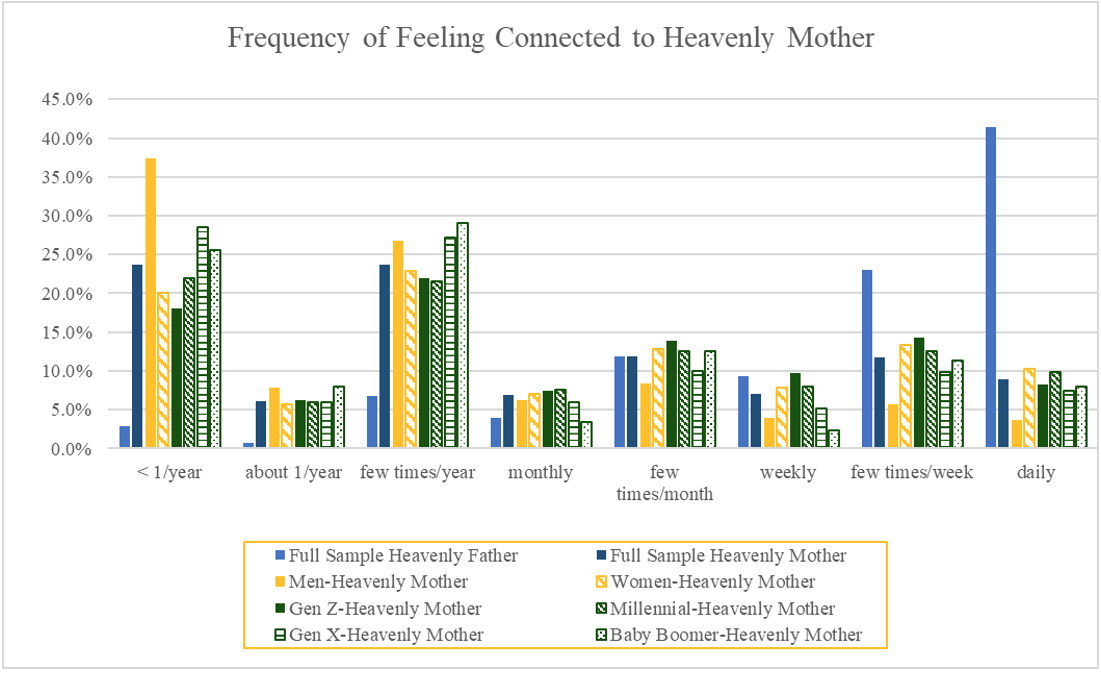
Figure 2. This figure shows the percentage of participants reporting how frequently they felt connected to their Heavenly Mother. A full sample comparison of connection with Heavenly Father is also included. Frequency of connection with Heavenly Mother, broken down by groups for comparison, are also included. Statistical analyses are presented in the text.
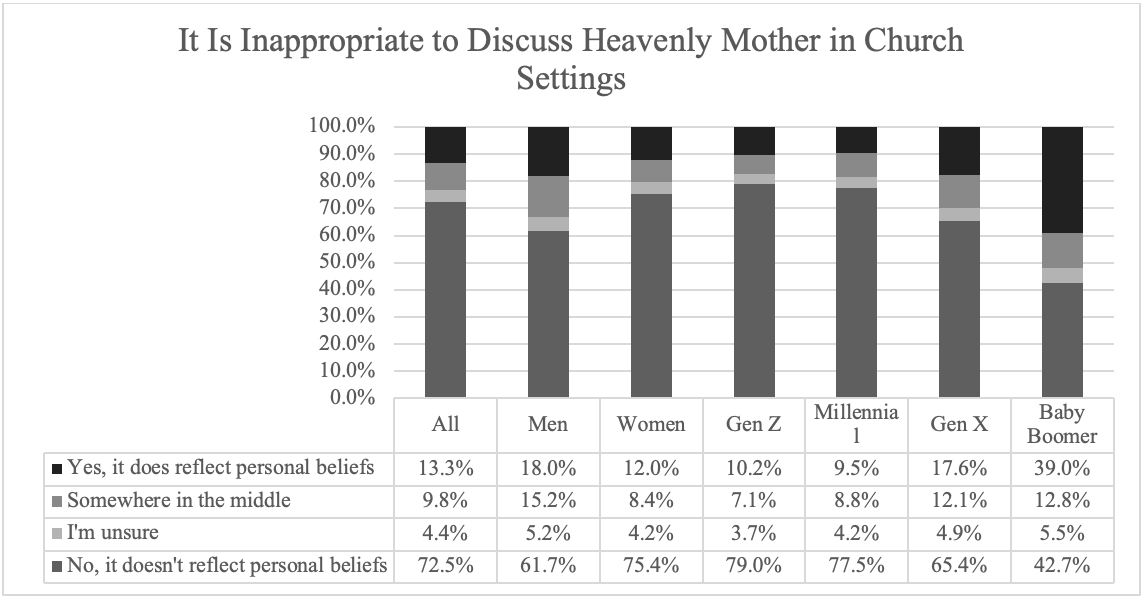
Figure 3. This figure shows the percentage of participants that feel that discussing Heavenly Mother in church settings is inappropriate reflects their personal belief. Responses broken down by groups for comparison are also included. Statistical analyses are presented in the text.

Figure 4. This figure shows the frequency participants reported hearing Heavenly Mother discussed in church settings. Responses broken down by groups for comparison are also included. Statistical analyses are presented in the text.
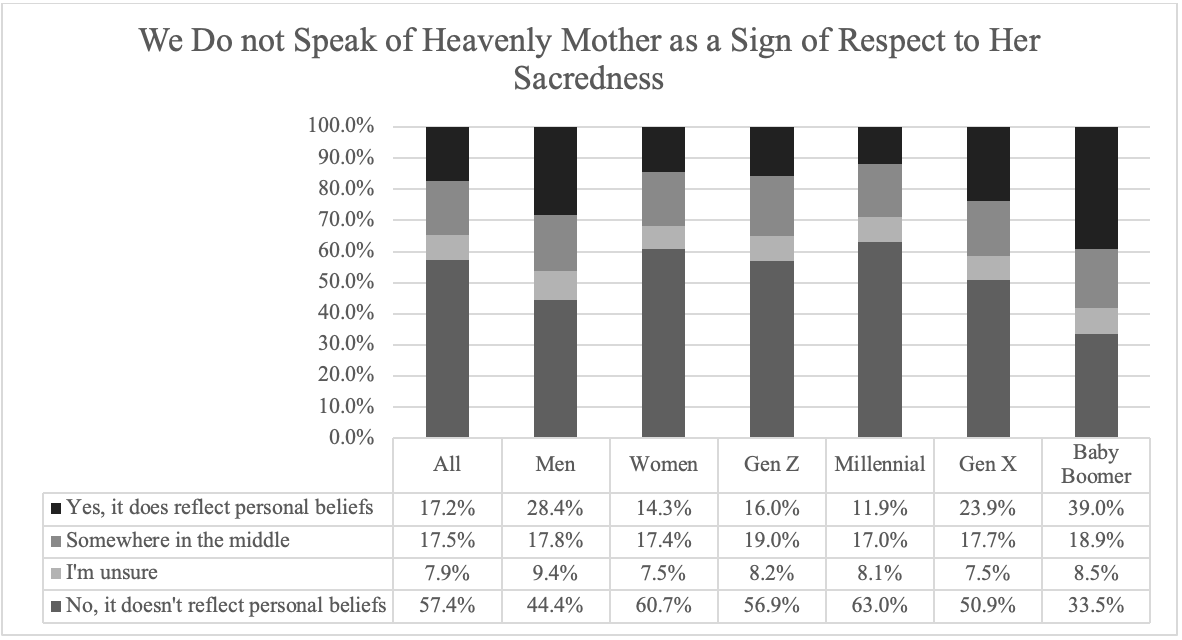
Figure 5. This figure shows the percentage of participants that feel that “we do not speak of Heavenly Mother as a sign of respect to Her sacredness” reflects their personal belief. Responses broken down by groups for comparison are also included. Statistical analyses are presented in the text.
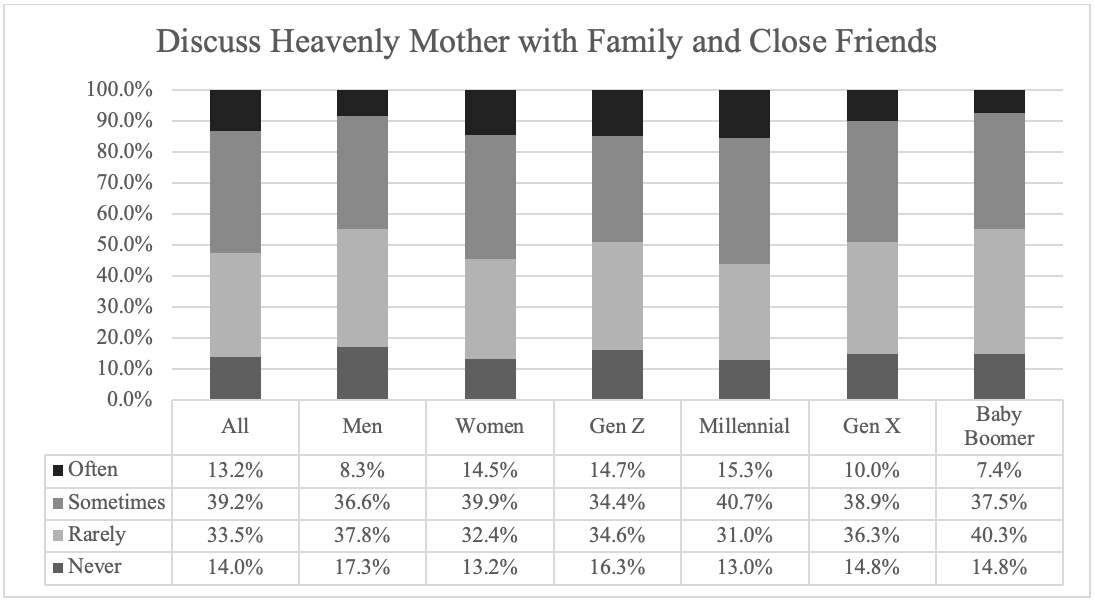
Figure 6. This figure shows the frequency participants reported hearing Heavenly Mother discussed in church settings. Responses broken down by groups for comparison are also included. Statistical analyses are presented in the text.
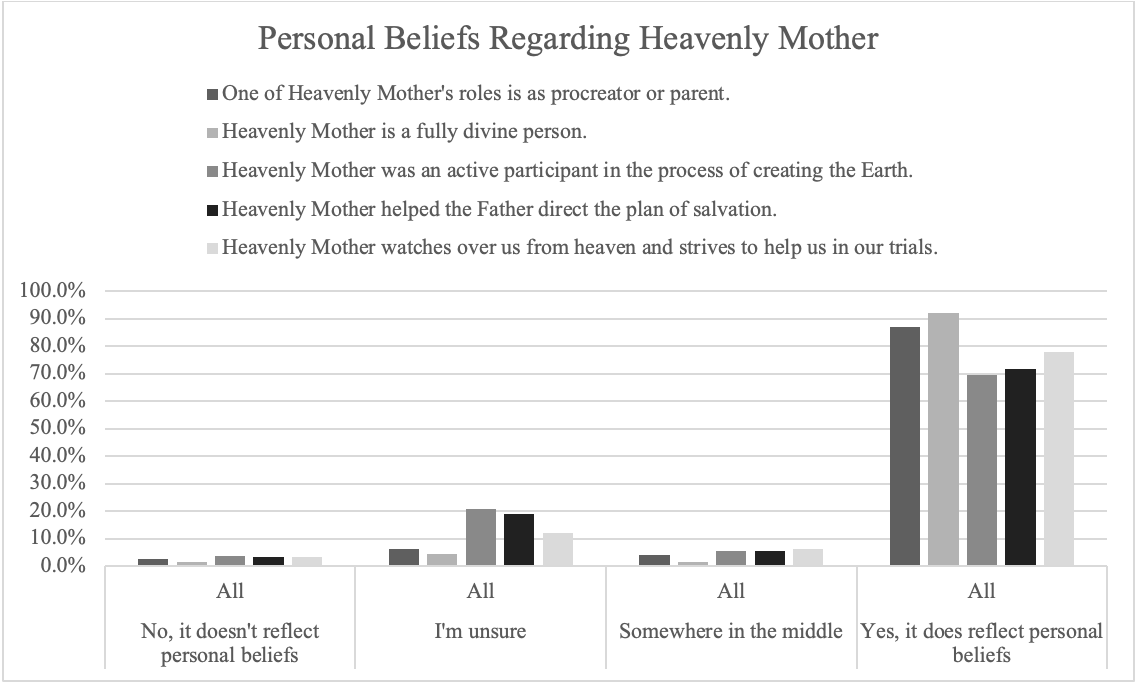
Figure 7. This figure shows participant responses to the five belief statements combined. More detailed charts for each belief are included.
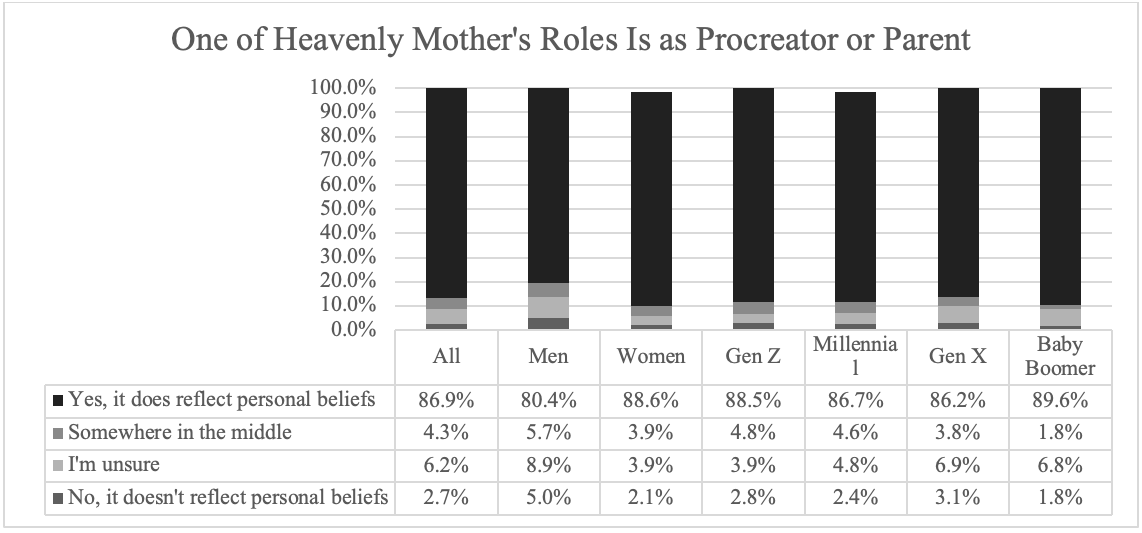
Figure 8. This figure shows the percentage of participants that feel that “one of Heavenly Mother’s roles is as procreator or parent” reflects their personal belief. Statistical analyses are presented in the text.
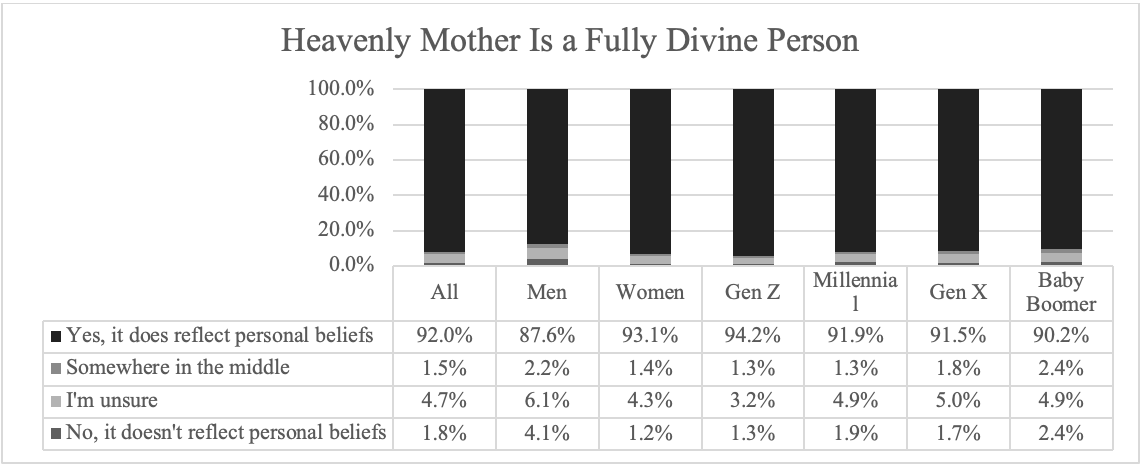
Figure 9. This figure shows the percentage of participants that feel that “Heavenly Mother is a fully divine person” reflects their personal belief. Responses broken down by groups for comparison are also included. Statistical analyses are presented in the text.
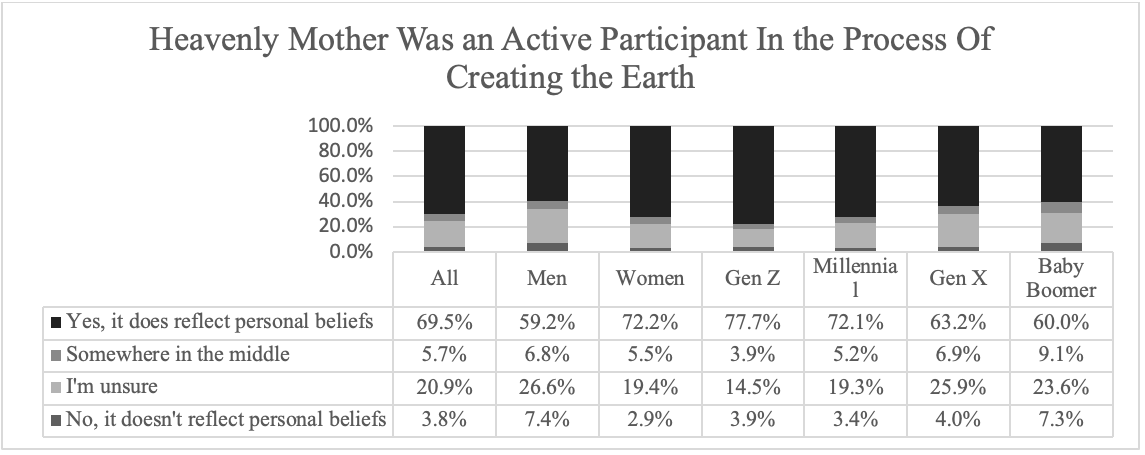
Figure 10. This figure shows the percentage of participants that feel that “Heavenly Mother was an active participant in the process of creating the Earth” reflects their personal belief. Responses broken down by groups for comparison are also included. Statistical analyses are presented in the text.
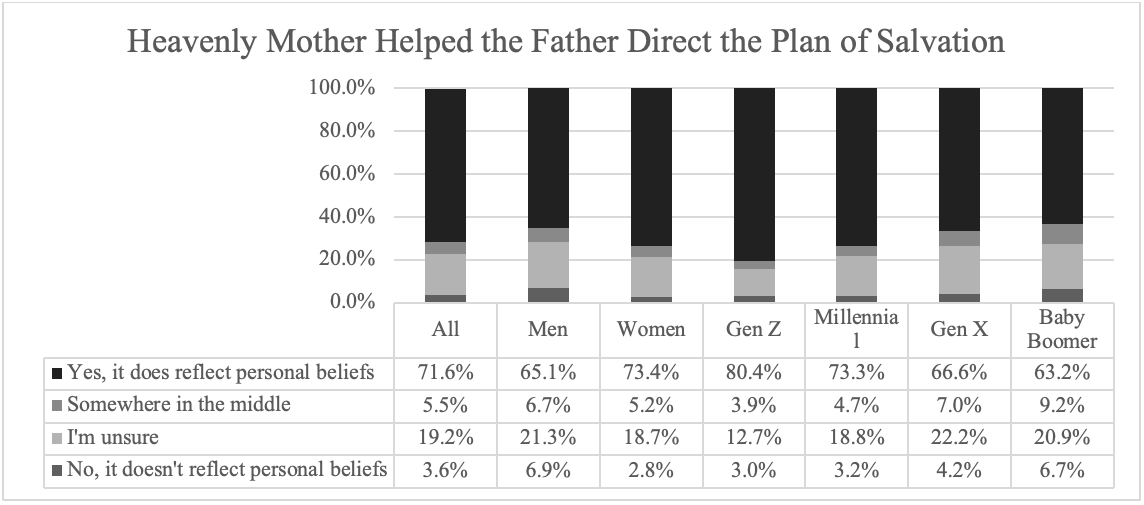
Figure 11. This figure shows the percentage of participants that feel that “Heavenly Mother helped the Father direct the plan of salvation” reflects their personal belief. Statistical analyses are presented in the text.

Figure 12. This figure shows the percentage of participants that feel that “Heavenly Mother watches over us from heaven and strives to help us in our trials” reflects their personal belief. Statistical analyses are presented in the text.
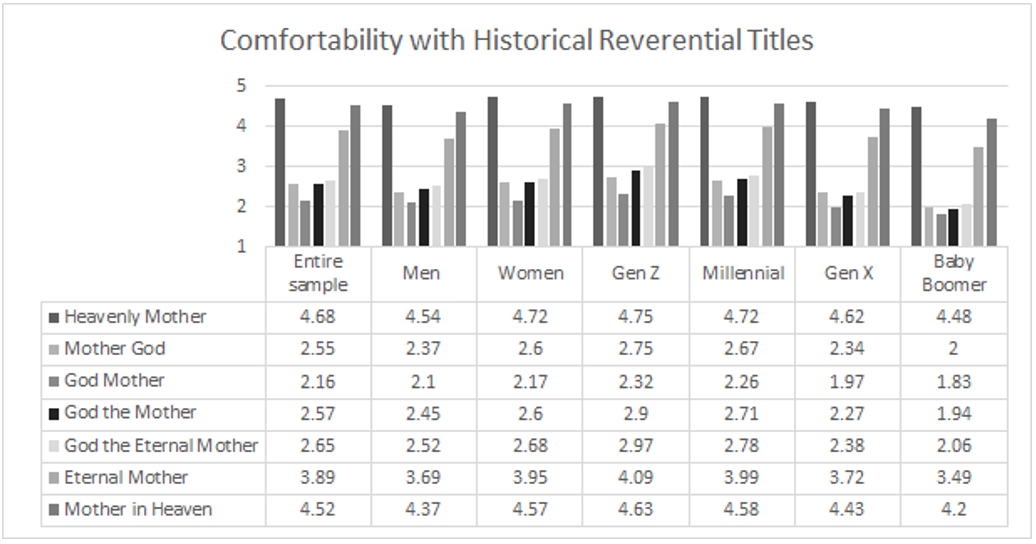
Figure 13. Throughout Church history, different reverential titles were used to refer to Heavenly Mother (Paulsen & Pulido, 2011). This chart reflects respondents’ comfortability with each title on a five-point scale: (1) not comfortable at all to (5) extremely comfortable. Statistical comparisons between these groups are reported in the text.
LINKS: APPENDIX
NOTES:
[1] The Church of Jesus Christ of Latter-day Saints, “Mother in Heaven,” 2015, https://www.churchofjesuschrist.org/study/manual/gospel-topics-essays/mother-in-heaven?lang=eng --- [Back to manuscript].
[2] Andrew L. Whitehead, “Gender Ideology and Religion: Does a Masculine Image of God Matter?,” Review of Religious Research 54, no. 2 (June 1, 2012): 139–56, https://doi.org/10.1007/s13644-012-0056-3 --- [Back to manuscript].
[3] see A Proclamation to the World: The Family and D&C 132:19-20. [Back to manuscript].
[4] Saints: The Story of the Church of Jesus Christ in the Latter Days, vol. 1, The Standard of Truth: 1815–1846 (The Church of Jesus Christ of Latter-day Saints, 2020), 404. [Back to manuscript].
[5] William Chase Harrison, “Our Mother in Heaven: Companion Hymn to E. R. Snow’s ‘Invocation,’” The Juvenile Instructor 29, no. 8 (April 15, 1894): 263–264; W. W. Phelps, “A Song of Zion,” SingPraises.net, accessed September 14, 2021, https://singpraises.net/collections/en/a-song-of-zion?edition=1844; E. R. Snow, “O My Father” in Hymns (The Church of Jesus Christ of Latter-day Saints, 1985), https://www.churchofjesuschrist.org/music/library/hymns/o-my-father?lang=eng&_r=1 --- [Back to manuscript].
[6] David Paulsen and Martin Pulido, “‘A Mother There’: A Survey of Historical Teachings about Mother in Heaven,” BYU Studies Quarterly 50, no. 1 (January 1, 2011), https://scholarsarchive.byu.edu/byusq/vol50/iss1/7 --- [Back to manuscript].
[7] Tyler Chadwick, Dayna Patterson, and Martin Pulido, eds., Dove Song: Heavenly Mother in Mormon Poetry (B10 Mediaworx, 2018). [Back to manuscript].
[8] Whitehead, “Gender Ideology and Religion”; Joshua A. Wilt et al., “Partnering with God: Religious Coping and Perceptions of Divine Intervention Predict Spiritual Transformation in Response to Religious−Spiritual Struggle,” Psychology of Religion and Spirituality 11, no. 3 (2019): 278–90, https://doi.org/10.1037/rel0000221 --- [Back to manuscript].
[9] W. Paul Reeve, Religion of a Different Color: Race and the Mormon Struggle for Whiteness (Oxford University Press, 2015). [Back to manuscript].
[10] Paulsen and Pulido, “A Mother There.” [Back to manuscript].
[11] Paulsen and Pulido. [Back to manuscript].
[12] The Church of Jesus Christ of Latter-day Saints, “Mother in Heaven.” [Back to manuscript].
[13] Chadwick, Patterson, and Pulido, Dove Song; McArthur Krishna and Bethany Brady Spalding, A Girl’s Guide to Heavenly Mother (D Street Press, 2020); Rachel Hunt Steenblik, I Gave Her a Name (By Common Consent Press, 2019). [Back to manuscript].
[14] Bethany Brady Spalding and McArthur Krishna, Our Heavenly Family, Our Earthly Families (Salt Lake City, Utah: Deseret Book, 2016). [Back to manuscript].
[15] Peggy Fletcher Stack, “In a Nod to Heavenly Mother, LDS Young Women’s Theme Changed to ‘Heavenly Parents,’” The Salt Lake Tribune, October 9, 2019, https://www.sltrib.com/religion/2019/10/06/lds-churchs-young-women/; Susan P Walker et al., “Inequality in Early Childhood: Risk and Protective Factors for Early Child Development,” The Lancet 378, no. 9799 (2011): 1325–38, https://doi.org/10.1016/S0140-6736(11)60555-2 --- [Back to manuscript].
[16] Kevin L. Barney, “Do We Have a Mother in Heaven?,” Foundation for Apologetic Information and Research (FAIR), 2001, https://www.fairlatterdaysaints.org/wp-content/uploads/2014/04/Kevin-Barney-MotherInHeaven.pdf; Val Larsen, “Hidden in Plain View: Mother in Heaven in Scripture,” SquareTwo, 2015, https://squaretwo.org/Sq2ArticleLarsenHeavenlyMother.html; Fiona Givens, “Feminism and Heavenly Mother,” in The Routledge Handbook of Mormonism and Gender, Routledge Handbooks in Religion (Routledge, 2020), 553–68; Blaire Ostler, “Heavenly Mother: The Mother of All Women,” Dialogue: A Journal of Mormon Thought 51, no. 4 (2018): 171–82; Daniel C. Peterson, “Nephi & His Asherah,” Journal of Book of Mormon Studies (1992-2007) 9, no. 2 (2000): 16–25. [Back to manuscript].
[17] Joshua B. Grubbs et al., “God Owes Me: The Role of Divine Entitlement in Predicting Struggles with a Deity,” Psychology of Religion and Spirituality 10, no. 4 (2018): 356–67, https://doi.org/10.1037/rel0000147; Nick Stauner, Julie J. Exline, and Joshua A. Wilt, “Meaning, Religious/Spiritual Struggles, and Well-Being,” in The Science of Religion, Spirituality, and Existentialism, ed. Kenneth E. Vail and Clay Routledge (Academic Press, 2020), 287–303, https://doi.org/10.1016/B978-0-12-817204-9.00021-4 --- [Back to manuscript].
[18] Wilt et al., “Partnering with God.” [Back to manuscript].
[19] Ashley N. Cooper et al., “God(s) in Minds: Understanding Deity Representation in Christian and Hindu Families through Social Relations Modeling,” Psychology of Religion and Spirituality 11, no. 2 (2019): 111–22, https://doi.org/10.1037/rel0000237 --- [Back to manuscript].
[20] Brien K. Ashdown et al., “Fathers and Perceptions of God Play an Important Role in Psychological Adjustment among Emerging Adults in Guatemala and the United States,” The Journal of Genetic Psychology 179, no. 5 (September 3, 2018): 270–85, https://doi.org/10.1080/00221325.2018.1502148 --- [Back to manuscript].
[21] Joseph O Baker and Andrew L Whitehead, “God’s Penology: Belief in a Masculine God Predicts Support for Harsh Criminal Punishment and Militarism,” Punishment & Society 22, no. 2 (April 1, 2020): 135–60, https://doi.org/10.1177/1462474519850570 --- [Back to manuscript].
[22] Whitehead, “Gender Ideology and Religion.” [Back to manuscript].
[23] Whitehead, p. 105. [Back to manuscript].
[24] The family: A proclamation to the world. Ensign, 25:11, 102. [Back to manuscript].
[25] Charlotte Shurtz, “Heavenly Mother in the Vernacular Religion of Latter-Day Saint Women,” Intermountain West Journal of Religious Studies 10, no. 1 (February 14, 2020): 29–57. [Back to manuscript].
[26] K Bach, “Understanding the ‘Seekers of Heavenly Mother’” (Global Women Studies Capstone Conference, Brigham Young University, 2021). [Back to manuscript].
[27] Paulsen and Pulido, “A Mother There.” [Back to manuscript].
[28] V. H. Cassler, “The Two Trees: An LDS Revisiting of the Garden of Eden,” SquareTwo, 2016, https://squaretwo.org/Sq2ArticleCasslerTwoTrees.html; Shurtz, “Heavenly Mother in the Vernacular Religion of Latter-Day Saint Women.” [Back to manuscript].
[29] Paulsen and Pulido, “A Mother There.” [Back to manuscript].
[30] Cassler, “The Two Trees: An LDS Revisiting of the Garden of Eden”; Shurtz, “Heavenly Mother in the Vernacular Religion of Latter-Day Saint Women”; J Graham-Russell, “Heavenly Mother Is a Black Woman: Exploring a Mormon Womanism,” By Common Consent (blog), April 23, 2017, https://bycommonconsent.com/2017/04/23/heavenly-mother-is-a-black-woman-exploring-a-mormon-womanism/ --- [Back to manuscript].
[31] It is important to note that a snowball design limits the generalizability of the findings. A much higher percentage of women responded to the social media recruitment than men. There may also be generational differences in those who fill out online surveys, in general. Demographic information regarding the sample is included to understand who this survey likely represents. It is not anticipated that it equally represents all members of the Church of Jesus Christ of Latter-day Saints. [Back to manuscript].
[32] For statistical analyses in social sciences, when comparing differences, p values are used to indicate statistical significance. A p value of .01 would suggest a 99% chance that the finding is not by chance. Likewise, a p value of .001 would suggest a 99.9% chance that the finding was not by chance. In our study, we only considered a p value as significant if it less than or equal to .05, or a 95% chance or greater of being accurate. Different fields set different standards. When we report significant associations, p values are included. [Back to manuscript].
[33] Karen L. Fingerman et al., “Giving to the Good and the Needy: Parental Support of Grown Children,” Journal of Marriage and Family 71 (2009): 1120–1233, https://doi.org/10.1111/j.1741-3737.2009.00665.x --- [Back to manuscript].
[34] MHeavenly Mother = 3.86(1.66), MHeavenly Father = 5.11 (1.51); t(4,558) = 49.19, p < .001 [Back to manuscript].
[35] Pearson correlation of relationship quality for Heavenly Father and Heavenly Mother (r = .41, p < .001) [Back to manuscript].
[36] Mmen = 3.58(1.61), Mwomen = 4.93(1.67); t(4,558) = −5.81, p < .001 [Back to manuscript].
[37] Pearson correlation between age and Heavenly Father relationship quality (r = .18, p < .001) and Heavenly Mother relationship quality (r = .02, ns). [Back to manuscript].
[38] ANOVA for generation and Heavenly Mother relationship quality (F = 3.78, p = .01) [Back to manuscript].
[39] Looking at age continuously, older participants reported having a closer relationship to Heavenly Father (r = .12, p < .001). By cohort, Gen Z and millennial were similar to each other and reported a less-close relationship to Heavenly Father than Gen X or baby boomer. Gen X participants had a closer relationship quality with Heavenly Father than Gen Z or millennial, but it was less close than baby boomer. Baby boomer participants reported a closer relationship to Heavenly Father than all the other groups (F = 50.06, p < .001). [Back to manuscript].
[40] Fingerman et al., “Giving to the Good and the Needy: Parental Support of Grown Children.” [Back to manuscript].
[41] MHeavenly Mother = 3.90(2.34), MHeavenly Father = 6.48(2.34); t(4,553) = 69.56, p < .001 [Back to manuscript].
[42] Pearson correlation for Heavenly Mother and Heavenly Father connection (r = .30, p < .001). [Back to manuscript].
[43] Mmen = 6.24(2.01), Mwomen = 6.54(1.88), t(4,556) = −4.54, p < .001, and Mmen = 2.94(2.01), Mwomen = 4.15(2.35), t(4,552) = −14.51, p < .001, Heavenly Father and Heavenly Mother, respectively. [Back to manuscript].
[44] Pearson correlation between age and Heavenly Mother connection (r = −.12, p < .001). By cohort, Gen Z and millennial were similar to each other and reported feeling connected more frequently with Heavenly Mother. Both Gen Z and millennial were both statistically different from Gen X and baby boomer, who both reported feeling connected less frequently (F = 19.27, p < .001). [Back to manuscript].
[45] As age increases, individuals felt connected more frequently with Heavenly Father (r = .12, p < .001). The breakdown by cohort shows that Gen Z and Gen X (likely parents and their children) reported being more connected to Heavenly Father than millennial but less connected than baby boomer. Millennial participants felt the least connected with Heavenly Father of all the groups, while baby boomer participants reported feeling connected to Heavenly Father more frequently than all the other groups (F = 50.06, p < .001). [Back to manuscript].
[46] Paulsen and Pulido, “A Mother There.” [Back to manuscript].
[47] Barney, “Do We Have a Mother in Heaven?”; Larsen, “Hidden in Plain View: Mother in Heaven in Scripture”; Givens, “Feminism and Heavenly Mother”; Ostler, “Heavenly Mother”; Peterson, “Nephi & His Asherah.” [Back to manuscript].
[48] Mmen = 1.28(1.68), Mwomen = .82(1.48); t(4,454) = 8.20, p < .001
[Back to manuscript].
[49] Pearson correlation for appropriateness of discussing Heavenly Mother in church settings and age (r = .21, p < .001). Specifically, Gen Z and millennial cohorts did not differ from each other but were less likely to feel it was inappropriate to discuss Heavenly Mother in church settings compared to Gen X and baby boomer. Gen X respondents felt that discussing Heavenly Mother in church settings was more inappropriate compared to Gen Z and millennial participants but felt it was less inappropriate than baby boomer. Baby boomer participants responded that they felt it was more inappropriate than all other cohorts to feel speaking of Heavenly Mother in church settings is inappropriate (F = 60.07, p < .001). [Back to manuscript].
[50] Mmen = 2.07(.68), Mwomen = 1.95(.61); t(4,555) = 5.14, p < .001 [Back to manuscript].
[51] Pearson correlation for discussing Heavenly Mother in church settings and age (r = .15, p < .001). Looking at each cohort specifically, Gen Z and millennial did not differ from each other, and they both reported less discussions of Heavenly Mother at Church compared with Gen X and baby boomers. Gen X participants reported more discussions of Heavenly Mother than Gen Z or millennial but less than baby boomer. Finally, baby boomer participants reported talking the most about Heavenly Mother in church settings (F = 30.37, p < .001). [Back to manuscript].
[52] Mmen = 1.86(1.75), Mwomen = 1.25(1.61); t(4,451) = 10.08, p < .001 [Back to manuscript].
[53] Pearson correlation between not speaking of Heavenly Mother as a sign of respect and age (r = .16, p < .001). Specifically, millennial participants were the least likely to believe that we do not speak of Heavenly Mother as a sign of respect to Her sacredness. Gen Z were more likely than millennial but less likely than Gen X or baby boomers to believe that we do not speak of Heavenly Mother as a sign of respect to Her sacredness. Gen X were more likely than Gen Z and millennial but less likely than baby boomer to believe that we do not speak of Heavenly Mother as a sign of respect to Her sacredness (F = 44.33, p < .001). [Back to manuscript].
[54] Mmen = 2.36(.86), Mwomen = 2.56(.90); t(4,550) = −6.14, p < .001 [Back to manuscript].
[55] Pearson correlation between discussing Heavenly Mother with close friends and family and age (r = −.06, p < .001). Looking at each cohort, Gen Z did not differ significantly from the other groups. Millennial participants discussed Her more with family and close friends than Gen X or baby boomer did. Gen X and baby boomer cohorts did not differ from each other, and they discussed Her less than millennial. [Back to manuscript].
[56] Kaitlin Hoelzer, “Seeking the Feminine Divine: Mormon Women’s Religious Authority and Power in Rachel Hunt Steenblik’s Poetry,” The Macksey Journal 1, no. 1 (2020): 21853. [Back to manuscript].
[57] Paulsen and Pulido, “A Mother There.” [Back to manuscript].
[58] Mmen = 3.57(1.01), Mwomen = 3.77(.73); t(4,445) = −6.92, p < .001
[Back to manuscript].
[59] Mmen = 3.69(.91), Mwomen = 3.85(.60); t(4,443) = c6.64, p < .001
[Back to manuscript].
[60] Pearson correlation between belief of Heavenly Mother as a divine person and age (r = −.03, p = .05). [Back to manuscript].
[61] Mmen = 3.10(1.23), Mwomen = 3.44(.99); t(4,438) = −8.73, p < .001
[Back to manuscript].
[62] Pearson correlation between belief of Heavenly Mother as an active participant in creating the earth and age (r = −.11, p < .001). Specifically, the generations fell into two groups. On the one hand, Gen Z and millennial cohorts did not differ from each other but were more likely to personally believe that Heavenly Mother was an active participant in the process of creating the earth. On the other hand, Gen X and baby boomer cohorts did not differ from each other, and they were less likely to believe that Heavenly Mother was an active participant in the process of creating the earth (F = 14.11, p < .001). [Back to manuscript].
[63] Mmen = 3.23(1.20), Mwomen = 3.46(.98); t(4,437) = −6.09, p < .001
[Back to manuscript].
[64] Pearson correlation between belief that Heavenly Mother helped the Father direct the plan of salvation and age (r = −.10, p < .001). Specifically, Gen Z was more likely than all other groups to endorse that Heavenly Mother helped the Father direct the plan of salvation. Millennial participants were more likely than Gen Z and less likely than Gen X and baby boomer participants to feel that Heavenly Mother helped the Father direct the plan of salvation reflected their personal beliefs. Gen X and baby boomer participants were similar to each other and both less likely than millennial and Gen Z participants in believing that Heavenly Mother helped the Father direct the plan of salvation (F = 11.99, p < .001). [Back to manuscript].
[65] Mmen = 3.30(1.17), Mwomen = 3.62(.88); t(4,437) = −9.17, p < .001
[Back to manuscript].
[66] Pearson correlation between belief that Heavenly Mother watches over us from heaven and age (r = −.09, p < .001). The generational pattern was a bit different than other statements. Gen Z was more likely than all others to feel that Heavenly Mother watches over us from heaven and strives to help us in our trials reflected their own personal beliefs. However, the millennial cohort followed a different pattern. They were less likely than Gen Z and more likely than Gen X but did not differ significantly from baby boomer in feeling that Heavenly Mother watches over us from heaven and strives to help us in our trials. Gen X participants were less likely than Gen Z and millennial participants, but they reported similarly to baby boomer participants. Finally, baby boomer participants only differed from Gen Z in reporting that Heavenly Mother watches over us from heaven and strives to help us in our trials (F = 11.65, p < .001). [Back to manuscript].
[67] Hoelzer, “Seeking the Feminine Divine.” [Back to manuscript].
[68] Hoelzer, “Seeking the Feminine Divine.” [Back to manuscript].
[69] Paulsen and Pulido, “A Mother There.” [Back to manuscript].
[70] Heavenly Mother, t(4,543) = −6.44, p < .001; Mother God, t(4,530) = −4.26, p < .001; God the Mother, t(4,531) = −2.98, p = .002; God the Eternal Mother, t(4,535) = −3.13, p = .002; Eternal Mother, t(4,531) = −5.07, p < .001; Mother in Heaven, t(5,444) = −5.78, p < .001 [Back to manuscript].
[71] Heavenly Mother, r = −0.10, p < .001; Mother God, r = −0.16, p < .001; God Mother, r = −0.13, p < .001; God the Mother, r = −0.20, p < .001; God the Eternal Mother, r = −0.19, p < .001; Eternal Mother, r = −0.14, p < .001; Mother in Heaven, r = −0.11, p < .001. For nearly all reverential titles (except God the Eternal Mother), Gen Z and millennial cohorts did not differ from each other and were more comfortable than both Gen X and baby boomer. For God the Eternal Mother, the Gen Z cohort was more comfortable than all other groups. The millennial cohort was less comfortable than Gen Z but more comfortable than both Gen X and baby boomer. The Gen X cohort was less comfortable than Gen Z and millennial but more comfortable than baby boomer for all reverential titles except Heavenly Mother and God Mother. In those two cases, Gen X and baby boomers cohorts did not differ from each other. [Back to manuscript].
[72] Stanisław Krajewski, “An Explanation of the Plural Form of God’s Name,” Eidos: A Journal for Philosophy of Culture 2, no. 2(4) (2018), https://doi.org/10.26319/4720 --- [Back to manuscript].
[73] Kevin A. Hallgren, “Computing Inter-Rater Reliability for Observational Data: An Overview and Tutorial,” Tutorials in Quantitative Methods for Psychology 8, no. 1 (2012): 23–34; Antonia Zapf et al., “Measuring Inter-Rater Reliability for Nominal Data—Which Coefficients and Confidence Intervals Are Appropriate?,” BMC Medical Research Methodology 16, no. 1 (August 5, 2016): 93, https://doi.org/10.1186/s12874-016-0200-9 --- [Back to manuscript].
[74] To create the Appendix, the authors each individually read all of the written responses (approximately 1,800) in their entirety. Each author then compiled responses that seemed notable in some way. The authors met and discussed their reasons for choosing the responses that they did. All the authors agreed that reading through the responses was a powerful experience. The Appendix highlights a selection of 100 participant comments that includes ideas that were mentioned rarely and were thus not coded as part of the common themes found in the main study. The selection of responses in the Appendix seemed fair to mention (e.g., that discussion of Heavenly Mother will lead to apostasy). Most importantly, the Appendix features a large sampling of the participants’ voices. Our goal was to give a sense of the variety of topics mentioned by participants. In addition, we hoped to capture the depth of responses and have included more examples of the responses given by multiple participants. [Back to manuscript].
[75] There were a number of notable limitations to the current research. Most notably, the study utilizes a convenience sample; thus, individuals who are already interested in Heavenly Mother may be more likely to respond, limiting the generalizability of the sample. Future research could utilize random sampling in the restored Church of Jesus Christ to obtain a more representative sample. Additionally, the sample overrepresents women. This was not surprising given the topic of a female deity, but we hope future research continues to examine male perceptions of Heavenly Mother. The sample is also not very ethnically diverse; thus, we encourage future research to utilize diverse and international populations. [Back to manuscript].
[76] Whitehead, “Gender Ideology and Religion.” [Back to manuscript].
[77] Paulsen and Pulido, “A Mother There.” [Back to manuscript].
[78] Paulsen and Pulido. [Back to manuscript].
[79] Whitehead, “Gender Ideology and Religion”; Wilt et al., “Partnering with God.” [Back to manuscript].
![]()
Full Citation for this Article: Amber J. Majeske, Sarah M. Coyne, Chelom E. Leavitt, Alice C. Long (2022) "“Your Mother and Mine”— Perceptions of Heavenly Mother Among Latter-day Saints," SquareTwo, Vol. 15 No. 3 (Fall 2022), http://squaretwo.org/Sq2ArticleMajeskeCoyneLeavittLong.html, accessed <give access date>.
![]() Would you like to comment on this article? Thoughtful, faithful comments of at least 100 words are welcome.
Would you like to comment on this article? Thoughtful, faithful comments of at least 100 words are welcome.